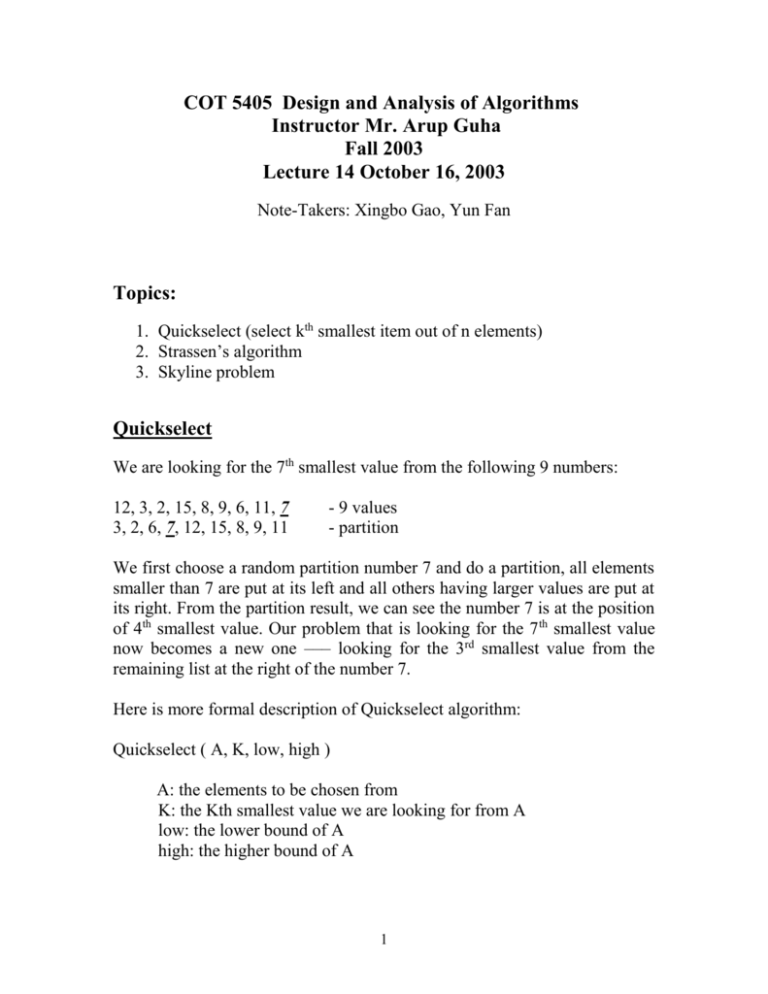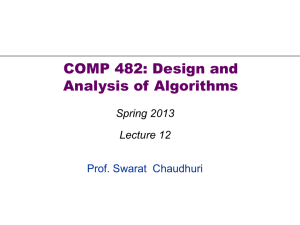Lecture 14
advertisement

COT 5405 Design and Analysis of Algorithms
Instructor Mr. Arup Guha
Fall 2003
Lecture 14 October 16, 2003
Note-Takers: Xingbo Gao, Yun Fan
Topics:
1. Quickselect (select kth smallest item out of n elements)
2. Strassen’s algorithm
3. Skyline problem
Quickselect
We are looking for the 7th smallest value from the following 9 numbers:
12, 3, 2, 15, 8, 9, 6, 11, 7
3, 2, 6, 7, 12, 15, 8, 9, 11
- 9 values
- partition
We first choose a random partition number 7 and do a partition, all elements
smaller than 7 are put at its left and all others having larger values are put at
its right. From the partition result, we can see the number 7 is at the position
of 4th smallest value. Our problem that is looking for the 7 th smallest value
now becomes a new one ––– looking for the 3rd smallest value from the
remaining list at the right of the number 7.
Here is more formal description of Quickselect algorithm:
Quickselect ( A, K, low, high )
A: the elements to be chosen from
K: the Kth smallest value we are looking for from A
low: the lower bound of A
high: the higher bound of A
1
{
int part = Partition ( A, low, high )
if ( K <= part )
Quickselect ( A, K, low, part-1 );
if ( K == part )
return A[part];
if ( K > part + 1 )
Quickselect ( A, k-part-1, part+1, high );
}
Homework#9: Do Average Case Executing Time Analysis for Quickselect
- O(n).
Best case analysis: partition in the middle of the array
T(n) = T(n/2) + O(n)
Plug in a=1, b=2, k=1
logba = 0, k=1 → T(n) = O(n)
Worst case analysis:
T( n ) = T(n-1) + O(n)
T(n-1) = T(n-2) + O(n-1)
T(n-2) = T(n-3) + O(n-2)
…
O(c(1+2+3+…+n))
║
O(c ·n(n+1)/2)
║
O(n2)
T(2) = T( 1 ) + O(2)
↓↓↓
T(n) = T(1) + O(n2)
→ T(n) = O(n2)
Strassen’s algorithm▬▬▬Matrix multiplication
The standard method of matrix multiplication of two n x n matrices takes
T(n) = O(n3).
2
The following is a simple algorithm to implement n x n matrix
multiplication:
Result = 0;
( initialize the array of Result )
for i = 1 to n
for j = 1 to n
for k = 1 to n
Result [i, j] += A[i, k] * B[k, j];
Stassen’s algorithm is a Divide-and-Conquer algorithm that beat the bound.
The usual multiplication of two n x n matrices takes
8
4
n/2 * n/2 matrix multiples plus
n/2 * n/2 matrix additions
T(n) = 8T(n/2) + O(n2)
Plug in
a = 8, b = 2, k = 2
→ logba =3 → T(n)= O(n3)
Strassen showed how two matrices can be multiplied using only 7
multiplications and 24 additions:
m1 = (a21 + a22 – a11) * (b22 – b12 + b11)
m2 = a11 * b11
m3 = a12 * b21
m4 = (a11 – a21) * (b22 – b12)
m5 = (a21 + a22) * (b12 – b11)
m6 = (a12 – a21 + a11 – a22) * b22
m7 = a22 * (b11 + b22 – b12 – b21)
3
T(n) = 7T(n/2) + O(n2)
↓
6 times as much as in the other algorithm
Skyline problem ——Divide-and-Conquer algorithm application
You are to design a program to assist an architect in drawing the skyline of a
city given the locations of the buildings in the city. To make the problem
tractable, all buildings are rectangular in shape and they share a common
bottom (the city they are built in is very flat). The city is also viewed as twodimensional. A building is specified by an ordered triple
where
and are left and right coordinates, respectively, of building i and is the
height of the building. In the diagram below buildings are shown on the left
with triples (1,11,5), (2,6,7), (3,13,9), (12,7,16), (14,3,25), (19,18,22),
(23,13,29), (24,4,28)
the skyline, shown on the right, is represented by the sequence: (1, 11, 3, 13,
9, 0, 12, 7, 16, 3, 19, 18, 22, 3, 23, 13, 29, 0)
You need to Merge two skylines——similar to the merge sort
4
For instance: there are two skylines,
Skyline A:
Skyline B:
a1, h11, a2, h12, a3, h13, …, an, 0
b1, h21, b2, h22, b3, h23, …, bm, 0
merge ( list of a’s, list of b’s) form into (c1, h11, c2, h21, c3, …, cn+m, 0)
Skyline problem algorithm should take a time of
T(n) = 2T(n/2) + O(n)
5











